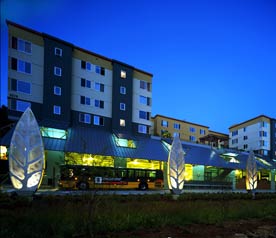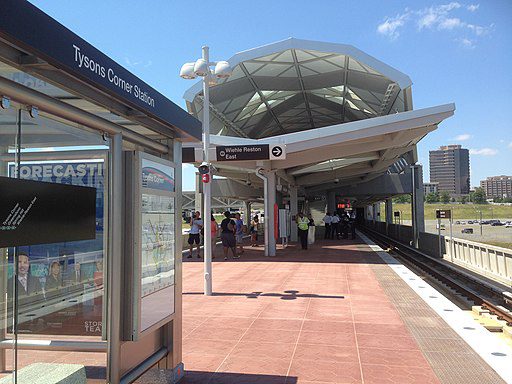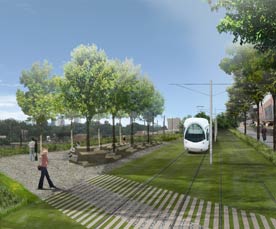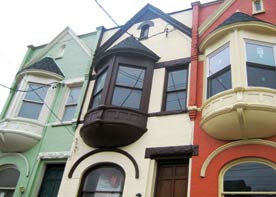Transit Equity Leads to TOD Equity
In Minneapolis, community groups in one low-income neighborhood had to fight to not be skipped over by transit entirely before they could get to the part about making surrounding development serve community needs.
The goal of the $941 million Central Corridor Light Rail Transit in Minneapolis and St. Paul is to connect the downtowns of the Twin Cities, moving people within a corridor that already has a high density of residents and jobs. The idea is less to focus on getting between St. Paul and Minneapolis fast than to encourage greater, more intense mixed-use development along the corridor.
“When it became clear that this project was actually moving forward, it also became clear that if neighborhoods didn’t get involved, they would have been left out of the process,” says Carol Swenson, executive director of the District Councils Collaborative (DCC) of Saint Paul and Minneapolis, formed nearly five years ago to facilitate neighborhood engagement, as an offshoot of University UNITED, a 28-year-old coalition that represents the business and neighborhood stakeholders of the University Avenue corridor. “We wanted to look carefully at the project and have influence.”
Part of that desire stemmed from a bad taste that was still present from the construction of Interstate 94 in the mid-20th century, which bisected Rondo, a historic black community; 650 homeowners lost their properties to eminent domain. The community was rolled over by professional planners, and the wounds have been reopened by the CCLRT, making involvement in this process all the more essential, Swenson said.
“It wasn’t just the light rail, but it was also the jobs, the affordable housing, the equitable development concerns, the environmental concerns, and the overwhelming opportunity behind it all. It’s not just about moving people; it’s getting people involved and providing economic development and revitalization catalysts that so many areas around this corridor need,” says Swenson.
That involvement turned out to be crucial. To get more points on a federal funding application that prioritized “efficiency,” three stations — Victoria, Hamline, and Western stations — at the eastern end of University Avenue, where there are high concentrations of low-income residents, were dropped from the plans. However, a three-year advocacy campaign, Stops for Us, not only got them restored, but convinced the federal government to change its funding rules, which DOT Secretary Ray LaHood announced in Minneapolis. The federal government will now match the city of St. Paul’s commitment of $5.2 million, which will pay for two stations. The third station’s funding was pieced together with local funds from the Counties Transit Improvement Board, Ramsey County, and the Central Corridor Funders Collaborative and will be matched by federal funds.
LaHood was quoted as telling organizers for Stops for Us, a coalition that pushed strongly for the inclusion of the three LRT stops, “You’ve made a difference and we will use you as an example across the country . . . that if you hang together, have a great project that’s for the people, and work with your delegation, you can make things happen.”
Swenson says the TOD around each of the stations will be “distinctly different.” Hamline serves a public housing high rise with a significant Somali population. They are seeking development and public realm improvements that add more eyes to the street, respond to their unique cultural needs, and improve safety, as well as bringing more options for small businesses.
The Victoria station is adjacent to single-family residences with the community opting for development more in scale with the neighborhood. There, commercial space is planned as an anchor for African-American businesses and to serve as a gateway to the historic Rondo neighborhood.
The Western station area is surrounded by Southeast Asian businesses, and has opportunities for redevelopment that is more dense than Victoria’s. The TOD here, now being branded as “Little Mekong,” would support new start-ups and business expansion.
“Arguably, these are the neighborhoods in the corridor that might benefit the most from equitable TOD,” says Swenson. She warns, however, that TOD can still put residents at risk for involuntary displacement due to changes in the housing market: “Ongoing community engagement will be essential so they don’t experience unbridled gentrification. Having the stations now creates opportunities they otherwise would not have had or would have had to wait a lot longer to experience.”
As the administration, foundations, states, and localities continue to rediscover the benefits of funneling development back toward transit hubs, it’s clear that there needs to be a balance struck, where grass-roots efforts shape transit oriented development projects that restore equitable development, promote economic development, and implement sound transportation policy. As exhibited in the Twin Cities and the Bay Area, where those efforts are strong, affordability and accessibility can be built in at the planning stages.






Comments